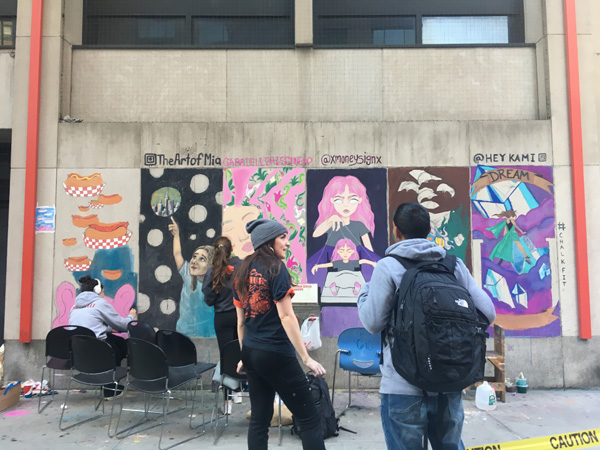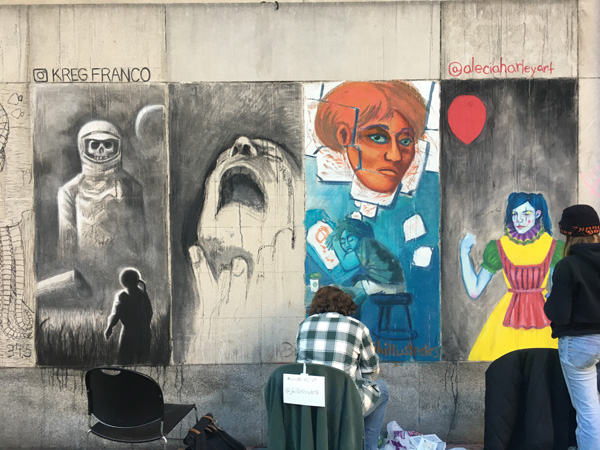
BY REBECCA FIORE | Brutalist architecture can be found all over New York City. The post-war minimalist movement, which peaked between the 1960s and mid-70s, was a response to highly refined and ornate buildings meant for the elite. Buildings such as the Guggenheim Museum, Kips Bay Plaza, and the Chatham Towers demonstrate a heavy use of exposed concrete to create a raw, sometimes uneasy, impression of fort-like strength and stability.
Many buildings across the country adopted this style, primarily government buildings such as Boston’s City Hall and college campuses such as Chelsea’s Fashion Institute of Technology (FIT).
When Dan Shefelman, an Assistant Professor of Illustration at FIT’s School of Art & Design, looked at the blank, 3×6 foot blocks of limestone used to create his workplace, he saw potential for a revamping. Five years ago, he launched the first ChalkFIT public art project with his class of senior illustration majors.
“We started in 2013 in the spring. It was spontaneous,” Shefelman recalled. “We were shocked how people responded. People with briefcases in hand stopping, some people asking for chalk, one little autistic girl spent three hours working while her mom watched. We saw the power of public art. It’s officially now part of the curriculum.”
Two buildings on the FIT campus serve as a canvas, extending along Seventh Ave. from W. 26th to 28th Sts. All illustration majors who are enrolled in the Mentor/Specialization Projects course participated in the chalk pastel painting process that began on Mon., Oct. 16 and lasted through Friday of that week.
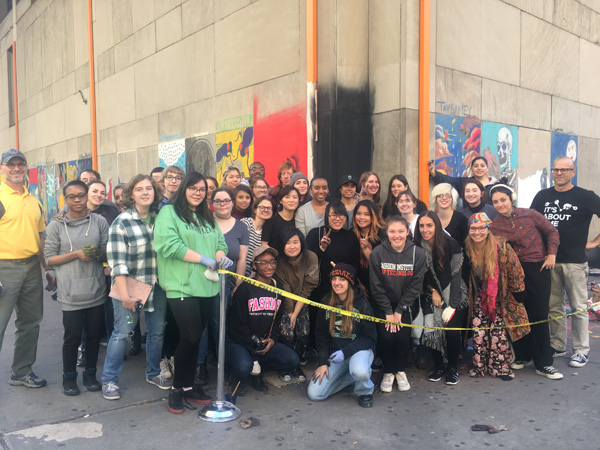
Shefelman described the class as a program that teaches students to respond to verbal props with a visual concept.
Every year the students and Shefelman come up with a theme. Last year’s theme was “Resilience and Diversity” in response to the Sept. 17, 2016 Chelsea bombings which occurred just weeks before the students took to their brushes. The students worked along a brick wall on W. 28th St. (btw. Seventh & Eighth Aves.) in acrylics.
“It’s really a new experience to them,” Shefelman said. “Most of them haven’t worked this big, on-site, with people watching. In the painting process, it’s as much of a performance as a piece of art. It’s amazing to watch the students realize how much people like what they do.”
This year, across 77 panels, mixed with seniors, alumni, and a few professors, the theme is “Dreams.”
When he was thinking of the this year’s theme, Shefelman said he thought of the Deferred Action for Childhood Arrivals (DACA) and the Development, Relief, and Education for Alien Minors (DREAM) Act.
“I didn’t want to do something explicitly political or something out of date in a week or two. The idea is dreaming, an antidote to the lack of imagination, without mentioning the unmentionable. … We want to talk about human imagination and the subconscious and your brain. How do you visualize that?”
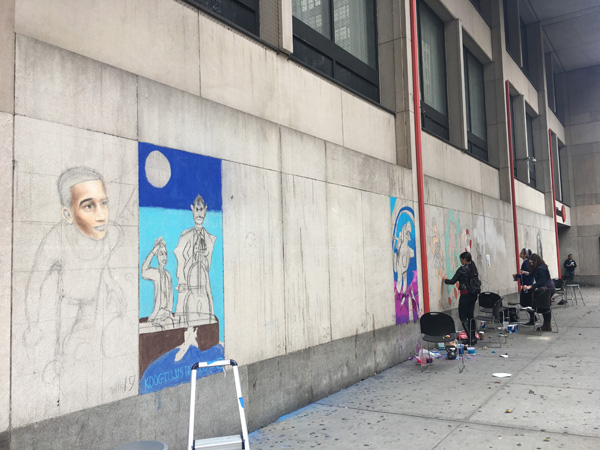
Above, panels in various states of development on the project’s first day. Below, the same stretch on the project’s third day. Photos by Rebecca Fiore.
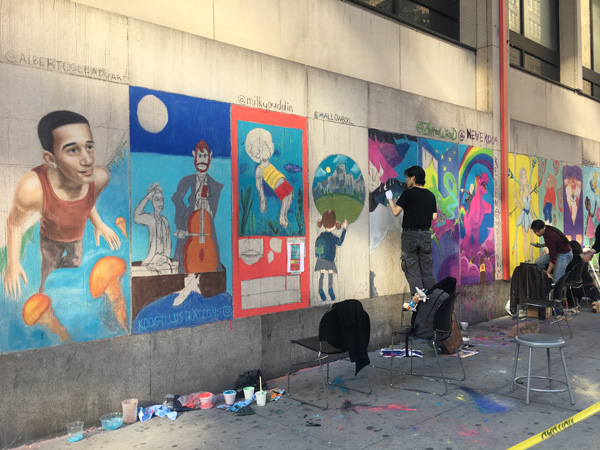
Some students took images from their own dreams — a large octopus, crystals under the moon, mushrooms growing in clusters, or fish swimming in space.
Annmarie Arnone said she wanted to focus on having a good time and experimenting with her art. She added vibrant colors and fantasy elements to make her panel have a more psychedelic feel to it.
“I wanted to do something out of the realm of what I would normally do,” Arnone said. “It’s a public piece, rather than a personal. It’s a lot of prep too. We came up with the ideas weeks ago. It’s a bigger scale too so you need more supplies. All the challenges that we are happy to figure out.”
Others thought of the dreams and aspirations of children such as a little boy who wants to be a firefighter, a young girl imagining a world bigger than her own, or a child playing with bubbles and toy boats.
“I wanted to show a child dreaming,” Jaqueline Carvalho said. “When I picture dreams, I always picture children. They always have big dreams that might not even make sense. I wanted to portray something whimsical too.”
Some of the artist also chose not to stay in the lines, or confinements, of their panels. Many students took a playful approach to dreaming, including Taylor Swierkowski and Julia Hemsworth.
“I’m 21 years old and I still have my teddy bear,” Swierkowski admitted. “I thought it would be kind of funny if my teddy bear were taking me to sleep.”
“We are in our senior year and we are all very tired,” Julia Hemsworth said. She explained her piece as “an art student dreaming about her painting being finished.”
Underneath each panel is a variety of chalk pigments, finely ground to be mixed with water. On one afternoon during the project, there was a shortage on white chalk. Shefelman said he ordered 42 cases of 144 colors of chalk in preparation.
Besides the cold weather earlier in the week, Mariesa Aguilar said the most difficult part of the process is transferring the image from paper to stone.
“The challenge that most people have, especially what I have, is to get it accurate,” she said. “From that drawing on the paper then onto the wall and to mix the colors together. The colors we use on paper are already premixed, whereas the chalk comes in certain colors so we have to mix them ourselves. It’s a messy process, don’t wear anything nice.”
Some artists have tools or rocks to smash their chalk. Stacey Figueroa used the bottom of her shoe and Anastasia Zuchko took to using her water bottle.
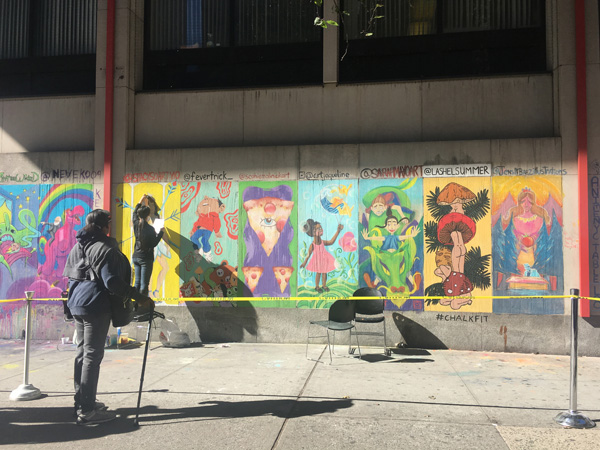
“It’s pretty much trial and error,” Carvalho said of her process. Alexa Kuebler added, “You just play with it because we don’t know what we are doing.”
Kuebler’s piece shows “a dream catcher that’s a tornado, coming down and circling me. The stars represent my dreams and how they will come true eventually.”
Every year, Shefelman said he hires Angel Garcia and Victor Saint-Hilarie, two alums who work for Groundswell (groundswell.nyc), an organization that brings artists, youths, and community organizations together through art, to help supervise the project.
The two created the main logo for this year’s theme, featured prominently under the Fred P. Pomerantz Art and Design Center sign.
Irina Fialko, a 2013 grad, said the program wasn’t around when she was in school, and she wasn’t an illustration major. But since graduating and continuing to be an assistant teacher at FIT, she was able to get a panel for herself. She noted that the past two years she wasn’t able to get a spot.
“It was a little daunting at first when I had to climb on top of the chair to paint, and it’s noisy, but you get into the groove of it. Some people have stopped to talk, which is nice,” Fialko said.
Sandra Krakowiak, said she was “most nervous about messing up in front of everyone.” But that she also enjoys connecting with classmates and watching friends work together.
Gerard Chambers actually prefers working outdoors. “It’s more organic,” he said. “You can feel the sun, the coolness of the wind.”
Kuebler said she has been waiting for this since she first toured the college campus four years ago. Swierkowski said it’s the reason why most people attend FIT. Arnone said the whole school gets excited for this time of year. Alecia Fuschetto said it’s a great opportunity for free advertising. The artists use #ChalkFIT on social media platforms such as Instagram, Twitter, and Facebook to attract attention. Many also added their profile handles, or usernames.
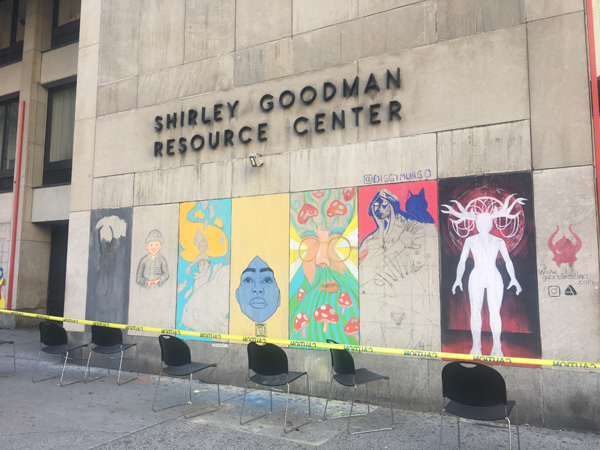
Above, a section of panels during the early days of the project. Below, the same section on the final day. Photos by Rebecca Fiore.
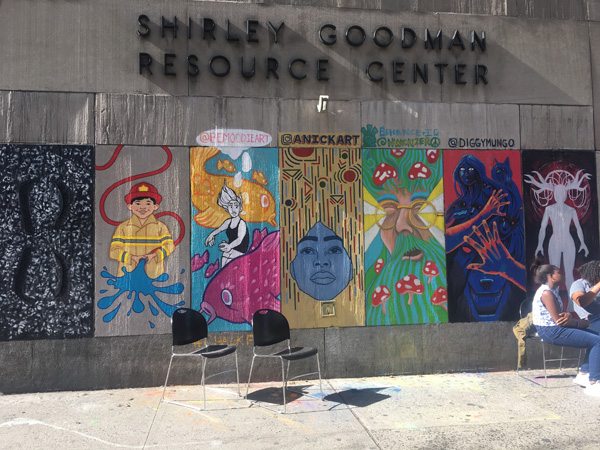
The panels will last through the winter if not longer, depending on the elements, Shefelman said (rain water or snow won’t cause these works to fade off so easily; they actually have to be power-washed off to completely disappear, when it comes time to make room for next year’s new theme).
“One of the greatest experiences for [the students] is they either go into it with total confidence and see how it comes across when others see it, or they go into it with fear and insecurity, and when it’s done, almost across the board, they have that confidence. I get choked up. Once they put the charcoal line on the wall, people stop and most of them have never had the experience of having direct reception of their work,” Shefelman said.
One passerby took a picture of Shannon Ramos’ piece, looked up and said, “Hey, is this yours? I just followed you on Instagram. Do you do album covers?”
For more info, visit facebook.com/ChalkFITNYC.
